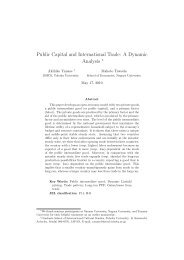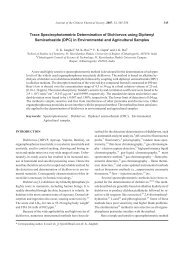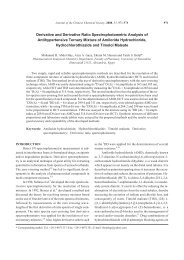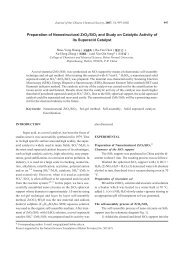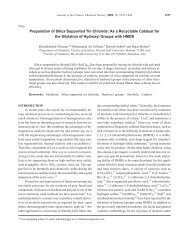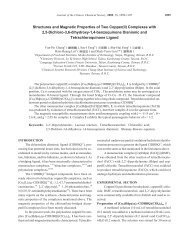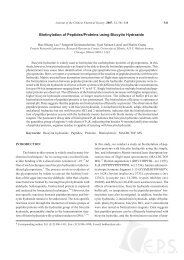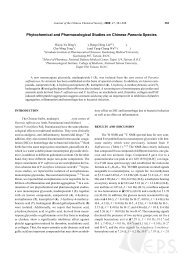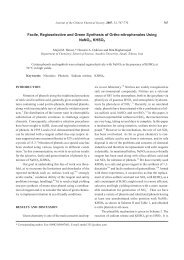Oxidation of 2-Phenylethylamine with N-Bromosuccinimide in Acid ...
Oxidation of 2-Phenylethylamine with N-Bromosuccinimide in Acid ...
Oxidation of 2-Phenylethylamine with N-Bromosuccinimide in Acid ...
You also want an ePaper? Increase the reach of your titles
YUMPU automatically turns print PDFs into web optimized ePapers that Google loves.
Journal <strong>of</strong> the Ch<strong>in</strong>ese Chemical Society, 2007, 54, 1223-1232 1223<br />
<strong>Oxidation</strong> <strong>of</strong> 2-<strong>Phenylethylam<strong>in</strong>e</strong> <strong>with</strong> N-<strong>Bromosucc<strong>in</strong>imide</strong> <strong>in</strong> <strong>Acid</strong> and<br />
Alkal<strong>in</strong>e Media: A K<strong>in</strong>etic and Mechanistic Study<br />
Kikkeri N. Mohana* and Paanemangalore M. Ramdas Bhandarkar<br />
Department <strong>of</strong> Studies <strong>in</strong> Chemistry, University <strong>of</strong> Mysore, Manasagangotri, Mysore - 570 006, India<br />
A k<strong>in</strong>etic study <strong>of</strong> oxidation <strong>of</strong> 2-phenylethylam<strong>in</strong>e (PEA), a bioactive compound, <strong>with</strong> potent oxidant,<br />
N-bromosucc<strong>in</strong>imide (NBS) has been carried out <strong>in</strong> HCl and NaOH media at 313 K. The experimental<br />
rate laws obta<strong>in</strong>ed are: -d [NBS]/dt = k[NBS][PEA][H ] <strong>in</strong> hydrochloric acid medium and -d [NBS]/dt<br />
= k[NBS][PEA] x [OH - ] y <strong>in</strong> alkal<strong>in</strong>e medium where x and y are less than unity. Accelerat<strong>in</strong>g effect <strong>of</strong> [Cl - ],<br />
and retardation <strong>of</strong> the added succ<strong>in</strong>imide on the reaction rate have been observed <strong>in</strong> acid medium. Variation<br />
<strong>of</strong> ionic strength <strong>of</strong> the medium shows negligible effect on rate <strong>of</strong> reaction <strong>in</strong> both media. Decrease <strong>in</strong><br />
dielectric permittivity <strong>of</strong> the medium decreased the rate <strong>in</strong> both media. The stoichiometry <strong>of</strong> the reaction<br />
was found to be 1:1 <strong>in</strong> acid medium and 1:2 <strong>in</strong> the case <strong>of</strong> alkal<strong>in</strong>e medium. The oxidation products <strong>of</strong> PEA<br />
were identified as the correspond<strong>in</strong>g aldehyde and nitrile <strong>in</strong> acid and alkal<strong>in</strong>e medium, respectively. The<br />
reactions were studied at different temperatures and the activation parameters have been evaluated. The<br />
reaction constants <strong>in</strong>volved <strong>in</strong> the proposed mechanisms were computed. The reaction was found to be<br />
faster <strong>in</strong> alkal<strong>in</strong>e medium <strong>in</strong> comparison <strong>with</strong> the acid medium, which is attributed to the <strong>in</strong>volvement <strong>of</strong><br />
different oxidiz<strong>in</strong>g species. The proposed mechanisms and the derived rate laws are consistent <strong>with</strong> the<br />
observed experimental results.<br />
Keywords: <strong>Oxidation</strong> k<strong>in</strong>etics; N-<strong>Bromosucc<strong>in</strong>imide</strong>; <strong>Acid</strong> and alkal<strong>in</strong>e media;<br />
2-<strong>Phenylethylam<strong>in</strong>e</strong>.<br />
INTRODUCTION<br />
2-<strong>Phenylethylam<strong>in</strong>e</strong> (PEA) is a naturally occurr<strong>in</strong>g<br />
endogenous am<strong>in</strong>e, which is present <strong>in</strong> several mammalian<br />
tissues 1 <strong>in</strong>clud<strong>in</strong>g the bra<strong>in</strong>. 2 2-<strong>Phenylethylam<strong>in</strong>e</strong> is formed<br />
by decarboxylation <strong>of</strong> am<strong>in</strong>o acid, L-phenylalan<strong>in</strong>e. 3 It<br />
crosses the presynaptic membrane and potentiates the postsynaptic<br />
effects <strong>of</strong> dopam<strong>in</strong>e. 4 PEA may act as neuromodulator<br />
<strong>of</strong> catecholam<strong>in</strong>e neurotransmission <strong>in</strong> the bra<strong>in</strong>. 4<br />
This bioactive am<strong>in</strong>e is also present <strong>in</strong> certa<strong>in</strong> foodstuffs<br />
such as chocolate, cheese and w<strong>in</strong>e and may cause undesirable<br />
side effects <strong>in</strong> susceptible <strong>in</strong>dividuals. 5 After review<strong>in</strong>g<br />
the literature we found that there was no <strong>in</strong>formation<br />
available on the oxidation k<strong>in</strong>etics <strong>of</strong> 2-phenylethylam<strong>in</strong>e<br />
<strong>with</strong> any oxidant. In view <strong>of</strong> its biological importance, the<br />
present study was undertaken to deal <strong>with</strong> the oxidation<br />
mechanism <strong>of</strong> PEA <strong>in</strong> acid and alkal<strong>in</strong>e media so that the<br />
study could throw some light on the fate <strong>of</strong> the compound<br />
<strong>in</strong> biological systems.<br />
N-bromosucc<strong>in</strong>imide (NBS) is a source <strong>of</strong> positive<br />
halogen, and this reagent has been selectively used as an<br />
oxidant for a variety <strong>of</strong> substrates <strong>in</strong> both acid and alkal<strong>in</strong>e<br />
media. 6-8 This potent oxidiz<strong>in</strong>g agent has been used <strong>in</strong> the<br />
oxidation <strong>of</strong> esters, 9 alcohols 10,11 and ketones. 12,13 In the<br />
present work the k<strong>in</strong>etics <strong>of</strong> oxidation <strong>of</strong> PEA <strong>with</strong> NBS <strong>in</strong><br />
acid and alkal<strong>in</strong>e media has been studied <strong>with</strong> a view to elucidate<br />
the mechanism <strong>of</strong> the reaction and to identify the reactive<br />
species <strong>of</strong> oxidant <strong>in</strong> acid and alkal<strong>in</strong>e media.<br />
RESULTS<br />
The oxidation <strong>of</strong> PEA <strong>with</strong> NBS was k<strong>in</strong>etically <strong>in</strong>vestigated<br />
at several <strong>in</strong>itial concentrations <strong>of</strong> the reactants<br />
<strong>in</strong> HCl and NaOH media. The salient features obta<strong>in</strong>ed <strong>in</strong><br />
these two media are discussed separately.<br />
K<strong>in</strong>etics <strong>of</strong> oxidation <strong>in</strong> acid medium<br />
Under pseudo-first-order conditions ([PEA] [NBS])<br />
at constant [HCl] and temperature, plots <strong>of</strong> log [NBS] vs.<br />
time were l<strong>in</strong>ear (r 0.994) <strong>in</strong>dicat<strong>in</strong>g a first-order dependence<br />
<strong>of</strong> rate on [NBS] o . The pseudo-first-order rate constants<br />
(k) calculated are given <strong>in</strong> Table 1. Further, the values<br />
<strong>of</strong> k calculated from these plots are unaltered <strong>with</strong> variation<br />
<strong>of</strong> [NBS] o , confirm<strong>in</strong>g the first-order dependence on<br />
[NBS] o . The rate <strong>in</strong>creased <strong>with</strong> <strong>in</strong>crease <strong>in</strong> [PEA] o (Table
1224 J. Ch<strong>in</strong>. Chem. Soc., Vol. 54, No. 5, 2007 Mohana and Ramdas Bhandarkar<br />
Table 1. Effect <strong>of</strong> vary<strong>in</strong>g concentrations <strong>of</strong> oxidant, substrate<br />
and HCl on the reaction rate at 313 K<br />
10 4 [NBS]<br />
(mol dm -3 )<br />
10 3 [PEA]<br />
(mol dm -3 )<br />
10 2 [HCl]<br />
(mol dm -3 )<br />
k 10 4<br />
(s -1 )<br />
1.0 08.0 5.0 3.62<br />
3.0 08.0 5.0 3.70<br />
5.0 08.0 5.0 3.56<br />
7.0 08.0 5.0 3.42<br />
9.0 08.0 5.0 3.67<br />
5.0 06.0 5.0 2.69<br />
5.0 10.0 5.0 4.60<br />
5.0 12.0 5.0 5.98<br />
5.0 14.0 5.0 6.81<br />
5.0 08.0 4.0 2.50<br />
5.0 08.0 6.0 4.79<br />
5.0 08.0 7.0 6.20<br />
5.0 08.0 9.0 8.87<br />
5.0* 08.0 5.0 3.62<br />
5.0** 08.0 5.0 3.66<br />
*ationicstrength() = 0.5 mol dm -3 and ** at = 0.75 mol dm -3<br />
1). A plot <strong>of</strong> log k vs. log [PEA] was l<strong>in</strong>ear (Fig. 1; r <br />
0.996) <strong>with</strong> the unit slope show<strong>in</strong>g first-order dependence<br />
<strong>of</strong> the rate on [PEA] o . Similarly, the rate <strong>of</strong> reaction <strong>in</strong>creased<br />
<strong>with</strong> <strong>in</strong>crease <strong>in</strong> [HCl] (Table 1). The order <strong>with</strong> respect<br />
to [HCl], as calculated from the slope <strong>of</strong> the plot <strong>of</strong><br />
log k vs. log [HCl], was found to be 1.31.<br />
The total [Cl - ] <strong>in</strong> the reaction mixture was kept constant<br />
at 0.15 mol dm -3 by add<strong>in</strong>g NaCl, then [H ] was varied<br />
by us<strong>in</strong>g HCl. The rate <strong>in</strong>creases <strong>with</strong> an <strong>in</strong>crease <strong>in</strong> [H ]<br />
(Table 2) and the plot <strong>of</strong> log k vs. log [H ] (Fig. 2) was<br />
found to be l<strong>in</strong>ear (r 0.999) <strong>with</strong> a unit slope <strong>in</strong>dicat<strong>in</strong>g<br />
first order dependence on [H ]. At constant [H ], addition<br />
Table 2. Effect <strong>of</strong> vary<strong>in</strong>g concentrations <strong>of</strong> H + and Cl - on the<br />
reaction rate at 313 K<br />
10 2 [H + ]<br />
(mol dm -3 )<br />
10 2 [Cl - ]<br />
(mol dm -3 )<br />
k 10 4<br />
(s -1 )<br />
3.0 15.0 03.27<br />
5.0 15.0 05.66<br />
7.0 15.0 08.04<br />
9.0 15.0 10.12<br />
10.0 15.0 11.39<br />
5.0 06.0 04.31<br />
5.0 08.0 04.72<br />
5.0 10.0 05.07<br />
5.0 12.0 05.37<br />
5.0 14.0 05.60<br />
[NBS] = 5 10 -4 mol dm -3 ;[PEA]=8 10 -3 mol dm -3 ; =0.25<br />
mol dm -3<br />
<strong>of</strong> chloride ions <strong>in</strong> the form <strong>of</strong> NaCl <strong>in</strong>creases the reaction<br />
rate and is shown <strong>in</strong> Table 2. From the plot <strong>of</strong> log k vs. log<br />
[Cl - ] (Fig. 2; r 0.999), the order <strong>with</strong> respect to [Cl - ]is<br />
found to be 0.32. Addition <strong>of</strong> succ<strong>in</strong>imide (NH) to the reaction<br />
mixture retards the rate (Table 3). Further, a plot <strong>of</strong> log<br />
k vs. log [NH] was l<strong>in</strong>ear (r 0.992) <strong>with</strong> a negative slope<br />
<strong>of</strong> 0.65 <strong>in</strong>dicat<strong>in</strong>g an <strong>in</strong>verse fractional-order dependence<br />
<strong>of</strong> the rate on [NH]. Variation <strong>of</strong> ionic strength <strong>of</strong> the medium<br />
(0.25-0.75 mol dm -3 ) and addition <strong>of</strong> mercuric acetate<br />
(0.001-0.01 mol dm -3 ) had no significant effect on the rate.<br />
Hence no attempt was made to keep ionic strength constant<br />
for k<strong>in</strong>etic runs.<br />
The effect <strong>of</strong> dielectric permittivity (D) on the reaction<br />
rate was studied by add<strong>in</strong>g various proportions <strong>of</strong><br />
Fig. 1. Plot <strong>of</strong> 4+logk versus 3+log[PEA].<br />
Fig. 2. Plot <strong>of</strong> 4+logk versus (2+log[H + ]) a or (2log<br />
[Cl - ]) b or (3log[OH - ]) c .
K<strong>in</strong>etics <strong>of</strong> <strong>Oxidation</strong> <strong>of</strong> 2-<strong>Phenylethylam<strong>in</strong>e</strong> J. Ch<strong>in</strong>. Chem. Soc., Vol. 54, No. 5, 2007 1225<br />
Table 3. Effect <strong>of</strong> vary<strong>in</strong>g concentration <strong>of</strong> succ<strong>in</strong>imide (NH) on<br />
the reaction rate <strong>in</strong> acid medium<br />
10 3 [NH] (mol dm -3 ) k 10 4 (s -1 )<br />
1.0 2.64<br />
2.0 1.75<br />
4.0 1.09<br />
5.0 0.91<br />
6.0 0.80<br />
[NBS] = 5 10 -4 mol dm -3 ;[PEA]=8 10 -3 mol dm -3 ;[HCl]=5<br />
10 -2 mol dm -3 ; = 0.25 mol dm -3 ; T = 313 K.<br />
CH 3 CN (0-20 v/v) to the react<strong>in</strong>g system. It was observed<br />
that an <strong>in</strong>crease <strong>in</strong> CH 3 CN composition decreased the rate<br />
and a plot <strong>of</strong> log k vs. log 1/D gave a straight l<strong>in</strong>e (r =<br />
0.999) <strong>with</strong> a negative slope (Fig. 3). The values are reported<br />
<strong>in</strong> Table 4. The values <strong>of</strong> permittivity for CH 3 CN-<br />
H 2 O mixtures are taken from the literature. 16,17 Blank experiments<br />
performed showed that CH 3 CN was not oxidized<br />
<strong>with</strong> NBS under the present experimental conditions. The<br />
reaction was studied at different temperatures (303-323 K),<br />
keep<strong>in</strong>g other experimental conditions constant. From the<br />
l<strong>in</strong>ear Arrhenius plot <strong>of</strong> log k vs. 1/T (Fig. 4; r 0.999), the<br />
values <strong>of</strong> activation parameters for the overall reaction<br />
were computed. The results are compiled <strong>in</strong> Table 5. Absence<br />
<strong>of</strong> free radicals dur<strong>in</strong>g the course <strong>of</strong> oxidation was<br />
confirmed when no polymerization was <strong>in</strong>itiated <strong>with</strong> addition<br />
<strong>of</strong> acrylonitrile solution to the reaction mixture.<br />
Table 4. Effect <strong>of</strong> vary<strong>in</strong>g dielectric permittivity <strong>of</strong> the medium<br />
on the reaction rate at 313 K<br />
%CH 3 CN<br />
(v/v)<br />
D<br />
<strong>Acid</strong> a<br />
k 10 4 (s -1 )<br />
Alkal<strong>in</strong>e b<br />
0 70.8 3.56 4.11<br />
5 69.0 2.72 3.61<br />
10 67.3 2.17 3.23<br />
15 65.7 1.70 2.87<br />
20 64.2 1.35 2.56<br />
a [NBS] = 5 10 -4 mol dm -3 ;[PEA]=8 10 -3 mol dm -3 ;[HCl]=<br />
5 10 -2 mol dm -3 ; = 0.25 mol dm -3 .<br />
b [NBS] = 5 10 -4 mol dm -3 ;[PEA]=8 10 -3 mol dm -3 ; [NaOH]<br />
=3 10 -2 mol dm -3 ; = 0.25 mol dm -3 .<br />
K<strong>in</strong>etics <strong>of</strong> oxidation <strong>in</strong> alkal<strong>in</strong>e medium<br />
With substrate <strong>in</strong> excess at constant [NaOH] and temperature,<br />
the [NBS] o was varied. Plots <strong>of</strong> log [NBS] vs.<br />
time were l<strong>in</strong>ear (r 0.998) <strong>in</strong>dicat<strong>in</strong>g a first-order dependence<br />
<strong>of</strong> the rate on [NBS] o . The pseudo first-order rate constants<br />
(k) obta<strong>in</strong>ed are listed <strong>in</strong> Table 6. The value <strong>of</strong> k <strong>in</strong>creased<br />
<strong>with</strong> an <strong>in</strong>crease <strong>in</strong> [PEA] o (Table 6), and a plot <strong>of</strong><br />
log k vs. log [PEA] was l<strong>in</strong>ear (Fig. 1; r = 0.999) <strong>with</strong> a<br />
slope <strong>of</strong> 0.58 <strong>in</strong>dicat<strong>in</strong>g a fractional-order dependence <strong>of</strong><br />
the rate on [PEA] o . Similarly, an <strong>in</strong>crease <strong>in</strong> [OH - ] <strong>in</strong>creased<br />
the rate (Table 6) and from the l<strong>in</strong>ear plot <strong>of</strong> log k vs. log<br />
[NaOH] (Fig. 2; r 0.998) an order <strong>of</strong> 0.76 was obta<strong>in</strong>ed<br />
and hence show<strong>in</strong>g the fractional-order dependence <strong>of</strong> rate<br />
on [NaOH].<br />
Addition <strong>of</strong> succ<strong>in</strong>imide (0.001-0.005 mol dm -3 ) and<br />
NaCl (0.005 mol dm -3 ) or variation <strong>of</strong> ionic strength <strong>of</strong> the<br />
medium us<strong>in</strong>g NaClO 4 solution (0.25-0.75 mol dm -3 )or<br />
mercuric acetate (0.001-0.01 mol dm -3 ) showed no significant<br />
effect on the rate. The rate decreased <strong>with</strong> <strong>in</strong>creas<strong>in</strong>g<br />
CH 3 CN content (0-20 v/v) and the results are shown <strong>in</strong><br />
Table 4. Plot <strong>of</strong> log k vs. 1/D was l<strong>in</strong>ear (Fig. 3; r 0.999)<br />
Fig. 3. Plot <strong>of</strong> 4+logk versus 10 2 /D.<br />
Fig. 4. Plot <strong>of</strong> 4+logk versus 10 3 /T.
1226 J. Ch<strong>in</strong>. Chem. Soc., Vol. 54, No. 5, 2007 Mohana and Ramdas Bhandarkar<br />
Table 5. Effect <strong>of</strong> vary<strong>in</strong>g temperature on the reaction rate and activation parameters for the<br />
oxidation <strong>of</strong> PEA<br />
k 10 4 (s -1 ) G (kJ mol -1 )<br />
Temperature (K)<br />
<strong>Acid</strong> Alkal<strong>in</strong>e <strong>Acid</strong> Alkal<strong>in</strong>e<br />
303 1.59 04.11 96.3 94.0<br />
308 2.36 05.11 96.9 95.0<br />
313 3.56 06.60 97.5 95.9<br />
318 5.25 08.65 98.0 96.7<br />
321 - 11.59 - 96.9<br />
323 7.68 - 98.6 -<br />
E a /kJ mol -1 64.9 42.9 - -<br />
H /kJ mol -1 62.3 40.4 - -<br />
S /J K -1 mol -1 -112.4 -177.0 - -<br />
[NBS] = 5 10 -4 mol dm -3 ;[PEA]=8 10 -3 mol dm -3 ; [HCl] = [NaOH] = 5 10 -2 mol dm -3 ;<br />
= 0.25 mol dm -3 .<br />
Table 6. Effect <strong>of</strong> vary<strong>in</strong>g concentrations <strong>of</strong> oxidant, substrate<br />
and alkali on the reaction rate at 313 K<br />
10 4 [NBS]<br />
(mol dm -3 )<br />
10 3 [PEA]<br />
(mol dm -3 )<br />
10 2 [NaOH] k 10 4 (s -1 )<br />
(mol dm -3 ) Experimental Calculated<br />
1.0 08.0 05.0 06.61 6.40<br />
3.0 08.0 05.0 06.58 6.40<br />
5.0 08.0 05.0 06.60 6.40<br />
7.0 08.0 05.0 06.64 6.40<br />
10.0 08.0 05.0 06.59 6.40<br />
5.0 02.0 05.0 02.89 2.61<br />
5.0 04.0 05.0 04.29 4.13<br />
5.0 06.0 05.0 05.45 5.41<br />
5.0 10.0 05.0 07.22 7.20<br />
5.0 12.0 05.0 08.18 7.96<br />
5.0 08.0 01.0 01.46 1.48<br />
5.0 08.0 03.0 04.11 4.28<br />
5.0 08.0 07.0 07.78 7.60<br />
5.0 08.0 10.0 10.67 9.98<br />
5.0* 08.0 05.0 06.71 -<br />
5.0** 08.0 05.0 06.69 -<br />
5.0 a 08.0 05.0 06.71 -<br />
5.0 b 08.0 05.0 06.72 -<br />
*At =0.5moldm -3 and ** at = 0.75 mol dm -3<br />
a [NH] = 0.002 mol dm -3 . b [NH] = 0.006 mol dm -3 .<br />
<strong>with</strong> a negative slope. Blank experiments performed <strong>in</strong>dicated<br />
that CH 3 CN was not oxidized <strong>with</strong> NBS under the experimental<br />
conditions employed. K<strong>in</strong>etic and thermodynamic<br />
parameters were calculated by study<strong>in</strong>g the reaction<br />
at different temperatures (303-321 K). A plot <strong>of</strong> log k vs.<br />
1/T was l<strong>in</strong>ear (Fig. 4; r 0.993). These results are given <strong>in</strong><br />
Table 5. Absence <strong>of</strong> free radicals <strong>in</strong> the reaction mixture<br />
has been demonstrated by the acrylonitrile test.<br />
DISCUSSION<br />
It has been shown 18-20 that probable reactive species<br />
<strong>of</strong> NBS <strong>in</strong> acid solution are NBS itself or Br + or protonated<br />
NBS viz., N + BSH, and the reactive species <strong>in</strong> alkal<strong>in</strong>e solutions<br />
are NBS, HOBr or OBr - . It may be po<strong>in</strong>ted out that all<br />
k<strong>in</strong>etic studies have been made <strong>in</strong> the presence <strong>of</strong> mercuric<br />
acetate <strong>in</strong> order to avoid any possible brom<strong>in</strong>e oxidation,<br />
which may be produced as follows:<br />
O<br />
O<br />
NBr<br />
+ HBr NH<br />
+ Br2<br />
Mercuric acetate acts as a capture agent for any Br -<br />
formed <strong>in</strong> the reaction and exists as HgBr 4 2 or unionized<br />
HgBr 2 and ensures that oxidation takes place purely through<br />
NBS. 21,22<br />
Mechanism and rate law <strong>in</strong> acid medium<br />
NBS is known to exist <strong>in</strong> acid medium <strong>in</strong> the follow<strong>in</strong>g<br />
equilibria:<br />
>NBr + H2 O NH + HOBr<br />
+<br />
+<br />
>NBr + H<br />
NHBr<br />
>NBr + H + NH +<br />
+<br />
Br<br />
Br+ + HO 2<br />
( HOBr) +<br />
(1)<br />
(2)<br />
(3)<br />
(4)<br />
(5)<br />
In the present studies the positive effect <strong>of</strong> [H + ]onthe<br />
2<br />
O<br />
O
K<strong>in</strong>etics <strong>of</strong> <strong>Oxidation</strong> <strong>of</strong> 2-<strong>Phenylethylam<strong>in</strong>e</strong> J. Ch<strong>in</strong>. Chem. Soc., Vol. 54, No. 5, 2007 1227<br />
reaction rate observed allows us to assume either protonated Scheme II<br />
NBS i.e., N + BSH or Br + or (H 2 OBr) + as active oxidiz<strong>in</strong>g<br />
+<br />
K5<br />
species, and negative effect <strong>of</strong> the <strong>in</strong>itially added product,<br />
+<br />
NBS + H NH + Br fast<br />
(i)<br />
K k k<br />
+<br />
dipole and a negative slope for a negative ion-dipole or dipole-dipole<br />
<strong>in</strong>teractions. In the present <strong>in</strong>vestigations, a<br />
k'<br />
1 2 3 [H ][S]<br />
= (9)<br />
k-2 + k 3 [NH]<br />
succ<strong>in</strong>imide restricts us to take Br + as the oxidiz<strong>in</strong>g species.<br />
+ k6<br />
On the basis <strong>of</strong> the above discussions and observed k<strong>in</strong>etic Br + S X<br />
fast<br />
(ii)<br />
- 6<br />
data, a probable mechanism (Scheme I) is proposed for the<br />
- k<br />
X + Cl<br />
7<br />
X<br />
oxidation <strong>of</strong> PEA.<br />
slow and rds (iii)<br />
k8<br />
X' + HO<br />
(iv)<br />
2 Products fast<br />
Scheme I<br />
NBS +<br />
+<br />
H<br />
K1<br />
NH +<br />
+<br />
Br fast (i) From slow step <strong>in</strong> Scheme II,<br />
+<br />
Br + S<br />
k2<br />
k_ 2<br />
X<br />
fast (ii) rate = k 7 [X] [Cl - ] (10)<br />
X<br />
k<br />
3<br />
X' slow and rds (iii) Apply<strong>in</strong>g steady state approximation for the species X, and<br />
k<br />
by solv<strong>in</strong>g [X], one obta<strong>in</strong>s,<br />
4<br />
X' + H O<br />
Products fast (iv)<br />
2<br />
+<br />
K k<br />
1 2[NBS][H ][S]<br />
[X] =<br />
(11)<br />
k-2 + k 3 [Cl<br />
-<br />
][NH]<br />
In Scheme I, S is the substrate, X is a Br + -S complex<br />
By substitut<strong>in</strong>g [X] from equation (11) <strong>in</strong>to equation (10),<br />
species and X is another <strong>in</strong>termediate complex species<br />
the follow<strong>in</strong>g rate law (equation 12) is obta<strong>in</strong>ed:<br />
whose structures are shown <strong>in</strong> Scheme III, where a detailed<br />
+<br />
mechanistic <strong>in</strong>terpretation <strong>of</strong> PEA oxidation by NBS <strong>in</strong><br />
K k [NBS][H ][S][Cl - ]<br />
1 2k rate<br />
3<br />
=<br />
(12)<br />
acid medium is proposed.<br />
k-2 + k 3 [Cl<br />
-<br />
][NH]<br />
Step (iii) <strong>of</strong> Scheme I determ<strong>in</strong>es the overall rate,<br />
rate = k 3 [X] (6)<br />
The rate law (12) clearly demonstrates the fractional<br />
order dependence <strong>of</strong> the rate on [Cl - ] and retardation <strong>of</strong> the<br />
rate by added succ<strong>in</strong>imide and is also <strong>in</strong> good agreement<br />
Apply<strong>in</strong>g steady state condition for X, it can be shown that,<br />
<strong>with</strong> the experimental results.<br />
S<strong>in</strong>ce rate = k [NBS], equation (12) can be transferred<br />
<strong>in</strong>to equation (13).<br />
+<br />
K k [NBS][H ][S]<br />
[X]<br />
1 2<br />
=<br />
(7)<br />
k-2 + k 3 [NH]<br />
+<br />
Kk [Cl<br />
-<br />
2 k 3 [H][S] ]<br />
k'<br />
1<br />
=<br />
(13)<br />
On substitut<strong>in</strong>g equation (7) <strong>in</strong> equation (6), the follow<strong>in</strong>g<br />
k -2 [NH] + k 3 [Cl<br />
-<br />
][NH]<br />
rate law [equation (8)] is obta<strong>in</strong>ed:<br />
Laidler and Ery<strong>in</strong>gs 23 have described the effect <strong>of</strong><br />
<br />
K1k 2k 3[NBS][H ][S]<br />
vary<strong>in</strong>g solvent composition on the reaction k<strong>in</strong>etics <strong>in</strong> detail.<br />
For the limit<strong>in</strong>g case <strong>of</strong> zero angle <strong>of</strong> approach be-<br />
rate = (8)<br />
k<br />
2[NH] k<br />
3[NH]<br />
tween two dipoles or an ion-dipole system, Emis 24 has<br />
S<strong>in</strong>ce rate k [NBS], rate law (8) can be transferred <strong>in</strong>to<br />
shown that a plot <strong>of</strong> log k vs. 1/D gives a straight l<strong>in</strong>e <strong>with</strong><br />
equation (9).<br />
a positive slope for a reaction <strong>in</strong>volv<strong>in</strong>g a positive ion and a<br />
plot <strong>of</strong> log k vs 1/D was l<strong>in</strong>ear <strong>with</strong> a negative slope. This<br />
Rate law (8) is <strong>in</strong> good agreement <strong>with</strong> the experimental results<br />
observed.<br />
observation <strong>in</strong>dicates the ion-dipole nature <strong>of</strong> the rate-determ<strong>in</strong><strong>in</strong>g<br />
step <strong>in</strong> the reaction sequence and also po<strong>in</strong>ts to<br />
In the presence <strong>of</strong> chloride ion at constant [H + ],<br />
the extend<strong>in</strong>g <strong>of</strong> the charge <strong>in</strong> the transition state. The <strong>in</strong>hibition<br />
<strong>of</strong> succ<strong>in</strong>imide on the rate suggests its<br />
Scheme II is proposed for the reaction mechanism.<br />
<strong>in</strong>volvement<br />
k
1228 J. Ch<strong>in</strong>. Chem. Soc., Vol. 54, No. 5, 2007 Mohana and Ramdas Bhandarkar<br />
Scheme III<br />
<strong>in</strong> a fast equilibrium prior to the rate-determ<strong>in</strong><strong>in</strong>g step. The<br />
fairly high positive values <strong>of</strong> Gibbs energy <strong>of</strong> activation<br />
and enthalpy <strong>of</strong> activation <strong>in</strong>dicate that the transition state<br />
is highly solvated. The large negative S suggests the formation<br />
<strong>of</strong> a compact activated complex <strong>with</strong> a reduction <strong>in</strong><br />
the degrees <strong>of</strong> freedom <strong>of</strong> molecules.<br />
Mechanism and rate law <strong>in</strong> alkal<strong>in</strong>e medium<br />
NBS is a two equivalent oxidant, which oxidizes many<br />
substrates through NBS itself, or hypobromite anion. 25-27<br />
The reaction exhibits 1:2 stoichiometry <strong>of</strong> PEA and NBS<br />
<strong>with</strong> unit order dependence on [NBS]. Increase <strong>in</strong> rate <strong>with</strong><br />
<strong>in</strong>creas<strong>in</strong>g [OH - ] can be well-expla<strong>in</strong>ed 27 by the formation
K<strong>in</strong>etics <strong>of</strong> <strong>Oxidation</strong> <strong>of</strong> 2-<strong>Phenylethylam<strong>in</strong>e</strong> J. Ch<strong>in</strong>. Chem. Soc., Vol. 54, No. 5, 2007 1229<br />
<strong>of</strong> oxidant species such as OBr - <strong>in</strong> the follow<strong>in</strong>g equilibrium:<br />
results observed.<br />
S<strong>in</strong>ce rate = k [NBS] t , equation (19) can be transferred<br />
<strong>in</strong>to equations (20) and (21).<br />
-<br />
NBS+OH - NH + OBr - (14)<br />
K [S][OH k'<br />
9K 10 k 11 ]<br />
=<br />
Insignificant effect <strong>of</strong> the added succ<strong>in</strong>imide on the rate can<br />
[H O]+ [OH<br />
-<br />
2 K9 ] + K 9 K 10 [S][OH ]<br />
K [NBS] [S][OH ]<br />
rate<br />
9K10k 11 t<br />
=<br />
(19)<br />
[H O] + [OH<br />
-<br />
2 K9 ] + K 9 K 10 [S][OH ]<br />
be attributed to the <strong>in</strong>volvement <strong>of</strong> the reactive species,<br />
1<br />
OBr - <strong>in</strong> the equilibrium below,<br />
k' = [H2O]<br />
K [S][OH]<br />
1<br />
+ +<br />
9K 10k 11<br />
K 10 k 11 [S]<br />
1<br />
HOBr + OH - OBr - +H 2 O (15)<br />
Hence, OBr - reacts <strong>with</strong> the substrate (S) to form a complex<br />
(X), which decomposes <strong>in</strong> a rate-limit<strong>in</strong>g step to give an <strong>in</strong>termediate<br />
(X). This <strong>in</strong>termediate reacts <strong>with</strong> one more<br />
molecules <strong>of</strong> the active species <strong>of</strong> oxidant <strong>in</strong> the fast step to<br />
give the products shown <strong>in</strong> Scheme IV. A detailed mechanistic<br />
<strong>in</strong>terpretation is shown <strong>in</strong> Scheme V.<br />
Scheme IV<br />
HOBr + OH<br />
K9<br />
OBr - + HO 2 fast (i)<br />
OBr - K 10<br />
+ S<br />
X<br />
fast (ii)<br />
X' +<br />
X<br />
HOBr<br />
k11<br />
k12<br />
X'<br />
Products<br />
slow and rds<br />
fast<br />
(iii)<br />
(iv)<br />
From the slow step <strong>of</strong> Scheme IV,<br />
rate = k 11 [X] (16)<br />
The total effective concentration <strong>of</strong> NBS is [NBS] t , then<br />
[NBS] t = [OBr - ] + [HOBr] + [X] (17)<br />
Solv<strong>in</strong>g for [HOBr] and [OBr - ] from steps (i) and (ii), one<br />
obta<strong>in</strong>s,<br />
K [NBS][S][OH 9K 10 t ]<br />
[X] =<br />
[H O] + K [OH<br />
-<br />
2 9 ] + K 9 K 10 [S][OH ]<br />
(18)<br />
By substitut<strong>in</strong>g [X] from equation (18) <strong>in</strong>to equation (16)<br />
one obta<strong>in</strong>s the follow<strong>in</strong>g rate law:<br />
Rate law (19) is <strong>in</strong> good agreement <strong>with</strong> the experimental<br />
(20)<br />
(21)<br />
Accord<strong>in</strong>g to equation (21), the plots <strong>of</strong> 1/k vs. 1/[S]<br />
(r = 0.995) and 1/k vs. 1/[OH - ](r 0.999) should be l<strong>in</strong>ear<br />
which is verified (Fig. 5). From the slopes and <strong>in</strong>tercepts <strong>of</strong><br />
such plots and [H 2 O] 55.56 mol dm -3 , the values <strong>of</strong> K 9 ,<br />
K 10 and k 11 were calculated. Us<strong>in</strong>g these values <strong>in</strong> rate<br />
equation (20), the rate constants under different conditions<br />
were calculated and compared <strong>with</strong> experimental values<br />
given <strong>in</strong> Table 6. There is a reasonable agreement between<br />
calculated and experimental rate constants.<br />
The negligible <strong>in</strong>fluence <strong>of</strong> the ionic strength <strong>of</strong> the<br />
medium and <strong>of</strong> the added halide ions is consistent <strong>with</strong> the<br />
proposed mechanism. The negative dielectric effect observed<br />
<strong>in</strong> the alkal<strong>in</strong>e medium shows charge dispersal <strong>in</strong><br />
the transition state, <strong>in</strong>dicat<strong>in</strong>g a negative ion-dipole <strong>in</strong>teraction<br />
<strong>in</strong> the rate-limit<strong>in</strong>g step. The sign and magnitude <strong>of</strong><br />
S as observed suggested that the activated complex is<br />
more compact than the ground state. The positive free energy<br />
<strong>of</strong> activation shows that the transition state is highly<br />
solvated.<br />
Fig. 5. Plot <strong>of</strong> 10 3 /k versus (10 2 /[PEA]) a or (10 2 /<br />
[OH - ]) b .<br />
k 11
1230 J. Ch<strong>in</strong>. Chem. Soc., Vol. 54, No. 5, 2007 Mohana and Ramdas Bhandarkar<br />
Scheme V<br />
EXPERIMENTAL<br />
An aqueous solution <strong>of</strong> NBS was prepared afresh<br />
each day from a G. R. Merck sample <strong>of</strong> the reagent, and its<br />
strength was checked by the iodometric method. 6 Analar<br />
grade 2-phenylethylam<strong>in</strong>e (Himedia) was used as received.<br />
All other reagents, namely hydrochloric acid, sodium perchlorate,<br />
mercuric acetate, succ<strong>in</strong>imide and sodium hydroxide,<br />
were <strong>of</strong> Analar grade. Doubly distilled water was<br />
used throughout the <strong>in</strong>vestigations.<br />
K<strong>in</strong>etic Measurements<br />
All k<strong>in</strong>etic measurements were performed <strong>in</strong> glass<br />
stoppered Pyrex boil<strong>in</strong>g tubes coated black to elim<strong>in</strong>ate<br />
photochemical effects. The reactions were carried out under<br />
pseudo first-order conditions by tak<strong>in</strong>g a known excess<br />
<strong>of</strong> [PEA] o over [NBS] o at 313 K. Appropriate amounts <strong>of</strong><br />
PEA, HCl or NaOH solutions, mercuric acetate, sodium<br />
perchlorate and water to keep the total volume constant<br />
were equilibrated at constant temperature ( 0.1 C). A<br />
measured amount <strong>of</strong> NBS solution also pre-equilibrated at<br />
the same temperature was rapidly added to the mixture. The<br />
progress <strong>of</strong> the reaction was monitored by estimat<strong>in</strong>g the<br />
amount <strong>of</strong> unconsumed NBS at regular time <strong>in</strong>tervals iodometrically.<br />
The course <strong>of</strong> reaction was studied for at least<br />
two half lives. The pseudo first-order rate constants (k),<br />
calculated from the l<strong>in</strong>ear plots <strong>of</strong> log [NBS] vs. time were<br />
reproducible <strong>with</strong><strong>in</strong> 4%. Regression analysis <strong>of</strong> the experimental<br />
data to obta<strong>in</strong> the regression co-efficient, r, was<br />
performed us<strong>in</strong>g an fx-570 MS scientific calculator.
K<strong>in</strong>etics <strong>of</strong> <strong>Oxidation</strong> <strong>of</strong> 2-<strong>Phenylethylam<strong>in</strong>e</strong> J. Ch<strong>in</strong>. Chem. Soc., Vol. 54, No. 5, 2007 1231<br />
Stoichiometry and Product Analysis<br />
Reaction mixtures conta<strong>in</strong><strong>in</strong>g vary<strong>in</strong>g ratios <strong>of</strong> NBS<br />
and PEA <strong>in</strong> the presence <strong>of</strong> 0.05 mol dm -3 HCl or NaOH at<br />
313 K were kept aside for 24 h, so that the substrate was<br />
completely converted <strong>in</strong>to products. Estimation <strong>of</strong> the unreacted<br />
NBS showed that one mole <strong>of</strong> substrate utilized one<br />
mole <strong>of</strong> oxidant <strong>in</strong> acid medium and one mole <strong>of</strong> substrate<br />
reacted <strong>with</strong> two moles <strong>of</strong> oxidant <strong>in</strong> alkal<strong>in</strong>e medium. The<br />
observed stoichiometry may be represented by the equations<br />
(1) and (2).<br />
where<br />
RNBr + RCH 2 CH 2 NH 2 +H 2 O <br />
RCH 2 CHO+RNH+NH 3 +H + +Br - (22)<br />
2RNBr + RCH 2 CH 2 NH 2 <br />
RCH 2 CN+2RNH+2H + + 2Br - (23)<br />
R = (CH 2 CO) 2 ;R =C 6 H 5 .<br />
The reduction product <strong>of</strong> NBS, succ<strong>in</strong>imide (NH),<br />
was detected by the method reported elsewhere. 14 The reaction<br />
mixture was extracted <strong>with</strong> ether and the oxidation<br />
product <strong>of</strong> PEA was found to be 2-phenylacetaldehyde <strong>in</strong><br />
acid medium and 2-phenylacetonitrile <strong>in</strong> the case <strong>of</strong> alkal<strong>in</strong>e<br />
medium. The aldehyde was detected by conventional<br />
spot tests 14 and also by 2,4-DNP derivatives. The nitrile<br />
was identified by its colour reactions 15 <strong>with</strong> hydroxylam<strong>in</strong>e<br />
and ferric chloride. Furthermore, the presence <strong>of</strong> aldehyde<br />
and nitrile was confirmed by their IR absorption bands<br />
1720 cm -1 (C=O stretch), 2850 cm -1 (aldehydic C-H stretch)<br />
2274 cm -1 (CN stretch) and 3025 cm -1 (aromatic C-H<br />
stretch).<br />
CONCLUSION<br />
In conclusion, the stoichiometry and products <strong>of</strong> oxidation<br />
<strong>of</strong> 2-phenylethylam<strong>in</strong>e <strong>with</strong> NBS <strong>in</strong> acid and alkal<strong>in</strong>e<br />
media are different. K<strong>in</strong>etic studies <strong>in</strong> acid medium reveal<br />
that Br + as active oxidant species oxidizes the substrate<br />
to the correspond<strong>in</strong>g aldehyde. In alkal<strong>in</strong>e medium<br />
the reaction takes place between the substrate and OBr - to<br />
form the correspond<strong>in</strong>g nitrile. The magnitude <strong>of</strong> the two<br />
activation energies (Table 4) <strong>in</strong>dicates that the PEA-NBS<br />
oxidation is faster <strong>in</strong> alkal<strong>in</strong>e medium compared to acid<br />
medium. The different active oxidiz<strong>in</strong>g species <strong>in</strong>volved <strong>in</strong><br />
the two media are responsible for the difference <strong>in</strong> activity.<br />
Hence, the k<strong>in</strong>etics <strong>of</strong> oxidation <strong>of</strong> PEA <strong>with</strong> NBS is more<br />
facile <strong>in</strong> alkal<strong>in</strong>e medium <strong>in</strong> comparison <strong>with</strong> acid medium.<br />
ACKNOWLEDGEMENTS<br />
The authors are thankful to University <strong>of</strong> Mysore,<br />
Mysore for f<strong>in</strong>ancial support.<br />
Received November 30, 2006.<br />
REFERENCES<br />
1. Nakajima, T.; Kakimoto, Y.; Sano, I. J. Pharmacol. Exp.<br />
Therap. 1964, 143, 314.<br />
2. Henry, D. P.; Russell, W. L.; Clemens, J. A.; Plebus, L. A. In<br />
Trace Am<strong>in</strong>es: Comparative and Cl<strong>in</strong>ical Neurobiology;<br />
Boulton, A. A., Ed.; Humana Press: Clifton, 1988; pp<br />
239-250.<br />
3. Dyck, L. E.; Yang, C. R.; Boulton, A. A. J. Neurochem. Res.<br />
1983, 10,211.<br />
4. Barroso, N.; Rodriguez, M. E. J. Pharmacol. 1996, 297, 195.<br />
5. Mart<strong>in</strong>, J. G.; Yee, M. M. Pediatr. Neurol. 2003, 28,9.<br />
6. Mathur, N. K.; Narang, C. R. The Determ<strong>in</strong>ation <strong>of</strong> Organic<br />
Compounds <strong>with</strong> N-bromosucc<strong>in</strong>imide; Academic Press:<br />
New York, 1975.<br />
7. Filler, R. Chem. Rev. 1963, 63, 21.<br />
8. Kamble, D. L.; Nandibewoor, S. T. Polish. J. Chem. 1997,<br />
71, 91.<br />
9. Radhakrishnamurthy, P. S.; Pati, S. C. J. Indian Chem. Soc.<br />
1969, 66(9), 847.<br />
10. Sr<strong>in</strong>ivasan, N. S.; Venkatasubramanian, N. Indian J. Chem.<br />
1971, 9, 726.<br />
11. Venkatasubramanian, N.; Thiagarajan, V. Can. J. Chem.<br />
1969, 47, 694.<br />
12. Pandey, L.; S<strong>in</strong>gh, K.; Mushran, S. P. Curr. Sci. 1978,<br />
47(17), 611.<br />
13. S<strong>in</strong>gh, K.; Tiwari, J. N.; Mushran, S. P. Int. J. Chem. K<strong>in</strong>et.<br />
1978, 10, 995.<br />
14. Fegiel, F.; Anger, V. Spot Tests <strong>in</strong> Organic Analysis;<br />
Elsevier: New York, 1975; pp 132, 195, 203.<br />
15. Soloway, S.; Lipschietz, A. Anal. Chem. 1952, 24, 898.<br />
16. Sreekumar, T. K.; Rajendran, G.; Kalidas, C. Indian J.<br />
Chem. 1992, 31A, 782.<br />
17. Niazi, S. K.; Ali, J. Bull. Chem. Soc. Jpn. 1990, 63, 3619.<br />
18. Berl<strong>in</strong>er, E. J. Chem. Edu. 1966, 43(3), 124.
1232 J. Ch<strong>in</strong>. Chem. Soc., Vol. 54, No. 5, 2007 Mohana and Ramdas Bhandarkar<br />
19. Bharat S<strong>in</strong>gh; Pandey, L.; Sharma, J.; Pandey, S.-M.<br />
Tetrahedran 1982, 38, 169.<br />
20. Thimmegowda, B.; Ishwara Bhat, J. Indian J. Chem. 1989,<br />
28A, 43.<br />
21. Bailer, J. C. The Chemistry <strong>of</strong> Coord<strong>in</strong>ation Compounds;<br />
Re<strong>in</strong>hold: New York, 1956; p 4.<br />
22. Gopalakrishnan, G.; Rai, B. R.; Venkatasubramanian, N. Indian<br />
J. Chem. 1980, 19B, 293.<br />
23. Laidler, K. J.; Eyr<strong>in</strong>gs, H. Am. N.Y. Acad. Sci. 1940, 39, 303;<br />
Laidler, K. J. Reaction K<strong>in</strong>etics; Pergamon: New York,<br />
1963.<br />
24. Emis, E. M. Solvent Effects on Reaction Rates and Mechanisms;<br />
Academic Press: New York, 1966.<br />
25. Saroja, P.; Kishore Kumar, B.; Sushma Kandlikar, Indian J.<br />
Chem. 1989, 28A, 501.<br />
26. Kamble, D. L.; Chougale, R. B.; Nandibewoor, S. T. Indian<br />
J. Chem. 1996, 35A, 865.<br />
27. Mavalangi, S. K.; Kembhavi, M. R.; Nandibewoor, S. T.<br />
Turk. J. Chem. 2001, 25, 355.<br />
28. Kamble, D. L.; Hugar, G. H.; Nandibewoor, S. T. Indian J.<br />
Chem. 1996, 35A, 144.





